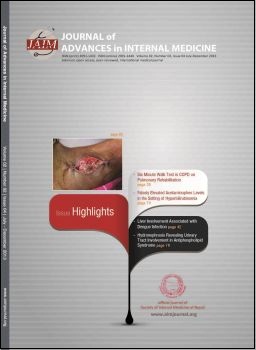An atypical hydronephrosis revealing urinary tract involvement in antiphospholipid syndrome
DOI:
https://doi.org/10.3126/jaim.v2i2.7659Keywords:
Antiphospholipid syndrome, Thrombosis, Hydronephrosis, Acute renal failureAbstract
Urinary tract involvement is rarely described in APS. We report the case of a 40 year-old man with primitive APS who was diagnosed an arterial and venous unilateral ureteral ischemia, revealed by a hydronephrosis. He had been on oral anticoagulation for six years because of two deep venous thromboses. He developed then a massive splenic infarct and an acute myocardial infarct, which required intensification of his anticoagulation, add of aspirin and high doses of corticosteroids. Three months later, he was explored for a latero-thoracic pain. Biology found an acute renal failure and microscopic haematuria. CT scan showed hypoperfusion of the left kidney, an ostial defect on renal artery and left hydronephrosis. Retrograde pyelography found a proximal ureteral stenosis. A dilatation with stenting failed, leading to a partial left ureteral resection. Histology confirmed ureteral segmental organized arterial thrombosis and venous thrombosis. Evolution was favourable with stabilization of creatinine level.
Urinary tract involvement is rarely described in antiphospholipid syndrome (APS). We report the case of a 40 year-old man with primitive APS who developed an arterial and venous unilateral ureteral ischemia revealed by painful unilateral hydronephrosis. The patient was on oral anticoagulation for six years because of two deep venous thromboses. He developed then a massive splenic infarct and an acute myocardial infarct, which required the intensification of his anticoagulation and high doses of corticosteroids. Three months later, he was explored for a latero-thoracic pain. Biology found an acute renal failure and microscopic haematuria. CT scan showed a hypoperfusion of the left kidney, an ostial defect on renal artery and a left hydronephrosis. Retrograde pyelography found a stenosis of the proximal ureter. A dilatation with stenting failed, leading to a partial left ureteral resection. Histology confirmed ureteral segmental organized arterial thrombosis and venous thrombosis. Evolution was favourable with stabilization of creatinine.
DOI: http://dx.doi.org/10.3126/jaim.v2i2.7659
Journal of Advances in Internal Medicine 2013;02(02):78-80
Downloads
Downloads
Published
How to Cite
Issue
Section
License
This license enables reusers to distribute, remix, adapt, and build upon the material in any medium or format, so long as attribution is given to the creator.




